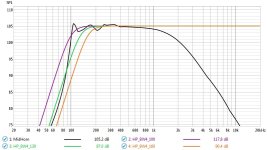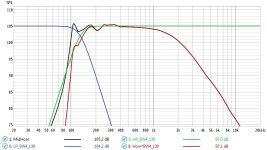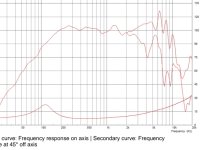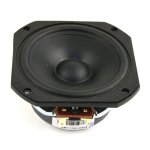Most compression drivers are rated for a frequency response low end, which is lower than the actual suggested crossover point.
E.G. many compression drivers have a good frequency response 500 to 16k but the suggested crossover point is at 800 Hz or so.
Not sure if this is for safety reasons, considering the demanding conditions these drivers subject to in P.A. applications, or if there are other reasons to suggest a higher xover point.
I use my compression drivers in home environment and they get a fraction of the rated power.
I am evaluating the possibility to use a RCF CD850 (rated at 500hz) or RCF N580 (450Hz) in a 300Hz Horn which I am planning to cross at 500.
Using a steep highpass (up 48db IIR and perhaps steeper FIR ) is not a problem.
I wonder if this is risky for the drivers and/or if I'd be facing issues with the quality of the emission (distortion, resonances etc.).
E.G. many compression drivers have a good frequency response 500 to 16k but the suggested crossover point is at 800 Hz or so.
Not sure if this is for safety reasons, considering the demanding conditions these drivers subject to in P.A. applications, or if there are other reasons to suggest a higher xover point.
I use my compression drivers in home environment and they get a fraction of the rated power.
I am evaluating the possibility to use a RCF CD850 (rated at 500hz) or RCF N580 (450Hz) in a 300Hz Horn which I am planning to cross at 500.
Using a steep highpass (up 48db IIR and perhaps steeper FIR ) is not a problem.
I wonder if this is risky for the drivers and/or if I'd be facing issues with the quality of the emission (distortion, resonances etc.).
For home use, the compression driver would not suffer. The question is the performance of the driver/horn combination. You would have to perform measurements to see how the combo works in real life.
I have a setup similar to what you are considering. The B&C DE75TN spec says 500-16K, recommended 800hz XO and I cross at 500Hz LR4 on a 270Hz horn. The only real problem is exceeding diaphragm Xmax if you like it excessively loud and want to cross low. You can tell in a measurement when the THD starts to rise too much. There is also an EQ tradeoff that reduces system sensitivity trying to cross low when the horn output and driver output are falling. Here is a measurement for comparison WN270 + DE75TN .
Thank you for the useful replies. Me too I had the idea it was a "better be safe than sorry" suggestion also based on the normal (ab)use of compression drivers.
Average SPL level @ my listening spot 4meters from the speakers is about 90db and the those drivers get less than 1 watt in average, (currently crossed at 900) so I guess I'm on the safe side.
Now, onto another matter and after reading the post you linked @DonVK.
I have two unused 300Hz Fc multicells which I have restored (basically repainted...) and would like to use. Question above was related to those horns.
General consensus is that the driver should be cut about one octave above the horn cutoff.
However, there are exception to this rule, namely Crowe's ES290 and Yuichi 290 which the designers claim can be used down to 300Hz without a problem.
Multicells horn share some characteristics with those horns, more with the Arai horns actually.
I wonder what issues I would be facing using those multicells down to the Fc limit and what to look for in the measurements.
Perhaps the coloration resulting from using the full bandwidth of a horn decreases with frequency ? That could make some sense also considering the characteristics of the human hearing at various frequencies.
P.S.
Of course in this case I would use a driver with an adequately rated low end response. I'm NOT planning cutting the 500Hz driver at 300.
Average SPL level @ my listening spot 4meters from the speakers is about 90db and the those drivers get less than 1 watt in average, (currently crossed at 900) so I guess I'm on the safe side.
Now, onto another matter and after reading the post you linked @DonVK.
I have two unused 300Hz Fc multicells which I have restored (basically repainted...) and would like to use. Question above was related to those horns.
General consensus is that the driver should be cut about one octave above the horn cutoff.
However, there are exception to this rule, namely Crowe's ES290 and Yuichi 290 which the designers claim can be used down to 300Hz without a problem.
Multicells horn share some characteristics with those horns, more with the Arai horns actually.
I wonder what issues I would be facing using those multicells down to the Fc limit and what to look for in the measurements.
Perhaps the coloration resulting from using the full bandwidth of a horn decreases with frequency ? That could make some sense also considering the characteristics of the human hearing at various frequencies.
P.S.
Of course in this case I would use a driver with an adequately rated low end response. I'm NOT planning cutting the 500Hz driver at 300.
Frequency response of the horn may be lumpy in the low end so the crossover frequency would depend on that. Also, it is desirable to match the dispersion angle of the horn to that of the bass unit at the crossover frequency so that would be a consideration.
That is most probably not the problem with multicellular horns. On the opposite that's a huge problem with late generation constant directivity horns most of which have 60° horizontal dispersion or less. Funny how nobody realize that and they all buy into the "last generation horns" narrative. Sorry...now they are called "waveguides". Guess "horn" is not politically correct.Also, it is desirable to match the dispersion angle of the horn to that of the bass unit at the crossover frequency so that would be a consideration.
Now, onto another matter and after reading the post you linked @DonVK.
I have two unused 300Hz Fc multicells which I have restored (basically repainted...) and would like to use. Question above was related to those horns.
General consensus is that the driver should be cut about one octave above the horn cutoff.
However, there are exception to this rule, namely Crowe's ES290 and Yuichi 290 which the designers claim can be used down to 300Hz without a problem.
Multicells horn share some characteristics with those horns, more with the Arai horns actually.
I wonder what issues I would be facing using those multicells down to the Fc limit and what to look for in the measurements.
Perhaps the coloration resulting from using the full bandwidth of a horn decreases with frequency ? That could make some sense also considering the characteristics of the human hearing at various frequencies.
P.S.
Of course in this case I would use a driver with an adequately rated low end response. I'm NOT planning cutting the 500Hz driver at 300.
The horn output roll off shape and slope will depend on the flare rate, and the lowest controlled wavefront will depend on the mouth size. The exception horns you mentioned are classic designs and you can find published data to support those claims. Often the marketing says "useful output to some freq" without stating any measurement details or graphs. It could be the specified horn output is -10dB (F10) at that lower freq. and for other horns it might be -3dB (F3). I've attached a pic of some horns I've sampled. Half of those horns (short and smaller mouths) have output attenuation of 10-15dB at the marketing "useful" lower freq claim.
IMO, the "octave rule" is conservative for a clean transition when matching acoustic slopes across the XO. Horns that support low cutoff freqs also tend to have more abrupt output attenuation below the cutoff freq. It depends on the system (horn + driver) and where you need the XO to match/blend polar beamwidth to the woofers. If you measure the system (horn+driver), you can tell where its combined rolloff occurs and where it misbehaves based on THD. If the system can manage the lower XO freq with acceptable measured THD , at the volumes needed, and you like the SQ, then all is good.
[edit] It's common to accept lower system sensitivity and XO the driver below it's cutoff spec for home use.
Attachments
Last edited:
@DonVK that was a very interesting reply.
I read somewhere that the electrical filter frequency and slope should be calculated so that the driver response does not intersect the acoustic slope the horn (other than much down in the db scale).
So a steeper electrical filter not only keeps low frequencies away from the driver, but also from the horn useful range.
Intersecting the driver and the horn response would cause massive phase shifts due to the horn slope adding to xover slope at some point, resulting in non a non linear filter and heavy phase shifts around the xover. Would be interesting to hear your thoughts about this subject.
I attach the power response of a midbass horn that I designed. What hipass filter would you try on it if you were in my shoes ?
Do you think a steep FIR filter would help extend the low end usability of the horn ?
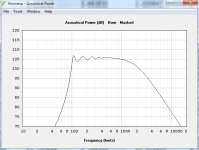
I read somewhere that the electrical filter frequency and slope should be calculated so that the driver response does not intersect the acoustic slope the horn (other than much down in the db scale).
So a steeper electrical filter not only keeps low frequencies away from the driver, but also from the horn useful range.
Intersecting the driver and the horn response would cause massive phase shifts due to the horn slope adding to xover slope at some point, resulting in non a non linear filter and heavy phase shifts around the xover. Would be interesting to hear your thoughts about this subject.
I attach the power response of a midbass horn that I designed. What hipass filter would you try on it if you were in my shoes ?
Do you think a steep FIR filter would help extend the low end usability of the horn ?

Certainly you'll get more phase shift with higher order IIR filters. All the systems are linear, so I don't see how you could take two linear systems and create a nonlinear system. The response of the system (horn+driver) is the convolved freq response of the driver and the horn and that's also linear. The problem is getting the separate driver and horn data, as they are usually combined. The DE75TN spec shows a system curve that falls off at 500Hz but its tested an ME75 horn which is the limiting LF factor (ignoring sensitivity, max SPL, THD)
We can use your Hornresp curve but we'll assume its actually the system (horn+driver) SPL axial response. However, this Hornresp graph is a power graph and at low freq, the pressure (dB SPL) will look similar to this power curve, At high freq the pressure curve will deviate from the power curve because the beamwidth is changing. Lets also assume for this example, we can ignore the beamwidth, the sensistivity, the max SPL, and the THD.
I digitized the Hornresp curve (no phase), and used BW4 filters because the system LF roll off is 4th order. We could also XO a bit lower freq with higher order filters or XO higher with lower order filters as you've suggested. I'm assuming we want to HP XO as low as possible. The first graph shows the system response and 3 *BW4 filters [100, 130, 160] Hz to show its 4th order and where the filter response intercepts the system response. In the second graph, I've selected Fc=130Hz, and I show the complementary LP BW4@130Hz, and the combined filter+system response. The combined "filter+system" curve deviates from ideal BW4 when it crosses the "system" curve at 105Hz, At this 105Hz intersection point the LP@104dB, the HP@97dB. and the combined (140dB+97dB) is 104.8dB and nearly the 105dB target. If the system+HP filter slope falls faster below 105Hz it will make no difference because it's below 97dB and sufficiently dominated by the LP.
We can use your Hornresp curve but we'll assume its actually the system (horn+driver) SPL axial response. However, this Hornresp graph is a power graph and at low freq, the pressure (dB SPL) will look similar to this power curve, At high freq the pressure curve will deviate from the power curve because the beamwidth is changing. Lets also assume for this example, we can ignore the beamwidth, the sensistivity, the max SPL, and the THD.
I digitized the Hornresp curve (no phase), and used BW4 filters because the system LF roll off is 4th order. We could also XO a bit lower freq with higher order filters or XO higher with lower order filters as you've suggested. I'm assuming we want to HP XO as low as possible. The first graph shows the system response and 3 *BW4 filters [100, 130, 160] Hz to show its 4th order and where the filter response intercepts the system response. In the second graph, I've selected Fc=130Hz, and I show the complementary LP BW4@130Hz, and the combined filter+system response. The combined "filter+system" curve deviates from ideal BW4 when it crosses the "system" curve at 105Hz, At this 105Hz intersection point the LP@104dB, the HP@97dB. and the combined (140dB+97dB) is 104.8dB and nearly the 105dB target. If the system+HP filter slope falls faster below 105Hz it will make no difference because it's below 97dB and sufficiently dominated by the LP.
Attachments
The sound quality between CDs pushed low (for them) vs. cones has come up a few times in some of my recent reading and the type of systems I'm working with, Cone vs. low-loaded CD has the most clear data I've seen to explain this phenomenon, specifically the drastically higher IMD from a compression driver at MF, but there are also mouth artifacts at play in those ranges with horns like the K402 or JBL 2374/2384. Intuitively it seems to be more appropriate to have a larger diaphragm where acoustic sources tend to be larger (In vocals, vibrations from the chest vs. fricatives from the mouth); while it's more complex than that, as a rule of thumb, you could do a lot worse.
The horn power response I posted above was modeled with a Celestion TF0510 cone driver. Doesn't hold much power for a midbass, but for home use 30watts are plenty and I managed to model a very smooth response with this driver, much smoother than many other I tried.
Frequency response of the Celestion TF0510 driver attached.
I am not planning to use using a compression driver on this horn.
I am comparing two options:
Option #1 would be a multicellular similar to the Altec 1505 but with somewhat lower Fc so that it is usable down to about 300 with a specific compression driver. I am not sure this driver even exists so I may decide to use the Celestion TF0510 on this horn as well. Actually I may use the 2" coaxials from B&C or Celestion 2050 but they are above the budget.
So I may cut it higher (450/500) and use a compression driver like RCF ND850.
Option #2 would be the horn posted above driven by the Celestion TF0510 cone driver.
I am not sure I really need this horn to extend that low as the Celestion TF0510 has a more or less straight response down to 200Hz.
So the question is if I really need 100hz Fc horn to cut the driver at 200 or if the horn can be made smaller (mouth) and shorter resulting in 150-200 Hz Fc and still be used down to about 200, with a steeper slope filter if necessary.
I have the possibility to use FIR filters as well, although not "brick wall" because the speaker manager accepts up to 512 taps on FIR filters (not enough for "true" brickwall but enough for almost vertical).
Below these horns an 18" woofer on a 250 liters ported box.
Frequency response of the Celestion TF0510 driver attached.
I am not planning to use using a compression driver on this horn.
I am comparing two options:
Option #1 would be a multicellular similar to the Altec 1505 but with somewhat lower Fc so that it is usable down to about 300 with a specific compression driver. I am not sure this driver even exists so I may decide to use the Celestion TF0510 on this horn as well. Actually I may use the 2" coaxials from B&C or Celestion 2050 but they are above the budget.
So I may cut it higher (450/500) and use a compression driver like RCF ND850.
Option #2 would be the horn posted above driven by the Celestion TF0510 cone driver.
I am not sure I really need this horn to extend that low as the Celestion TF0510 has a more or less straight response down to 200Hz.
So the question is if I really need 100hz Fc horn to cut the driver at 200 or if the horn can be made smaller (mouth) and shorter resulting in 150-200 Hz Fc and still be used down to about 200, with a steeper slope filter if necessary.
I have the possibility to use FIR filters as well, although not "brick wall" because the speaker manager accepts up to 512 taps on FIR filters (not enough for "true" brickwall but enough for almost vertical).
Below these horns an 18" woofer on a 250 liters ported box.
Attachments
Last edited:
If you are crossing at 200Hz using a cone driver, no need for a horn with an Fc of 100Hz, as long as the driver's excursion stays under Xmax at the desired output level.Option #1 would be a multicellular similar to the Altec 1505 but with somewhat lower Fc so that it is usable down to about 300 with a specific compression driver.
Option #2 would be the horn posted above driven by the Celestion TF0510 cone driver.
I am not sure I really need this horn to extend that low as the Celestion TF0510 has a more or less straight response down to 200Hz.
So the question is if I really need 100hz Fc horn to cut the driver at 200 or if the horn can be made smaller (mouth) and shorter resulting in 150-200 Hz Fc and still be used down to about 200, with a steeper slope filter if necessary.
A larger mouth will have smoother response near Fc.
Here is a relatively small two part 2" throat conical (Maltese) horn with an Fc of ~228Hz:
And it's response with a 3.5" Tymphany TC9FD cone driver, (1 liter back chamber, no phase plug, ragged upper response) and an Electro-Voice DH1A (3" diaphragm, 2" exit):
The $23 cone driver has more clean LF output than compression drivers costing more than 10 times the amount. The old DH1A beat out newer models in every metric I could test.
There is no replacement for displacement, and HF compression drivers have very little, <1mm.
Some midrange compression drivers like the Altec 290 or JBL 2482 (both phenolic) have slightly more diaphragm to phase plug distance, allowing a 300Hz crossover.
But in my experience, those drivers just don't sound as good near Fc as cones whether it's IM distortion, or air-non linearity from the high compression ratios or whatever.
Art
@weltersys that's very interesting.
I don't mind the ragged upper response as the horn should be used up to 800/1khz.
Wow I'm surprised such small horn having so good low end response ! What is the throat diameter on that horn you posted ?
The Altec 1505 multicell is much bigger at 16.5" x 30.5" and 18.5" long and it is rated at only 500hz with the Altec 290.
Wonder if redisigning the cells a little for somewhat lower Fc it could be made usable to 200Hz or so with the TC9FD.
I really love those multicell wide dispersion and costant directivity, no beaming at all. Somewhat time consuming to DIY, but good things don't come easy.
Is Vifa TC9FD attached, same as Timphany ?
I don't mind the ragged upper response as the horn should be used up to 800/1khz.
Wow I'm surprised such small horn having so good low end response ! What is the throat diameter on that horn you posted ?
The Altec 1505 multicell is much bigger at 16.5" x 30.5" and 18.5" long and it is rated at only 500hz with the Altec 290.
Wonder if redisigning the cells a little for somewhat lower Fc it could be made usable to 200Hz or so with the TC9FD.
I really love those multicell wide dispersion and costant directivity, no beaming at all. Somewhat time consuming to DIY, but good things don't come easy.
Is Vifa TC9FD attached, same as Timphany ?
Attachments
- Home
- Loudspeakers
- Multi-Way
- Minimum low cut frequency on compression drivers

